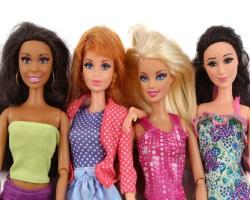The super-thin, busty original Barbie isn’t going anywhere, but she’ll be sharing shelf space with curvy, petite and tall Barbies. The changes don’t stop there. Barbie now comes with two different sized feet, for instance, and they’re reticulated so the doll can wear flat shoes along with her traditional heels. All these different sizes can cause problems. Two different feet require two different shoe sizes, for instance—but designers worried that designating numbers for those sizes might suggest that one size was better than the other. So, different shoe sizes are labeled not with a 1 and 2, but with a B and a picture of Barbie’s face.
Then there’s this: While moms may appreciate Barbie’s new diversity in body shape, girls in test groups seem to prefer the traditional Barbie. One 7-year-old said the new Barbie is “f-a-t,” spelling out the word because she doesn’t want to “hurt her feelings.”
“We see it a lot,” says Tania Missad, a researcher for Mattel. “The adult leaves the room, and they undress the curvy Barbie and snicker a little bit. For me, it’s these moments when it just really sets in how important it is we do this. In time, I would love it if a girl wouldn’t snicker and just think of it as another beautiful doll.” (Time)

